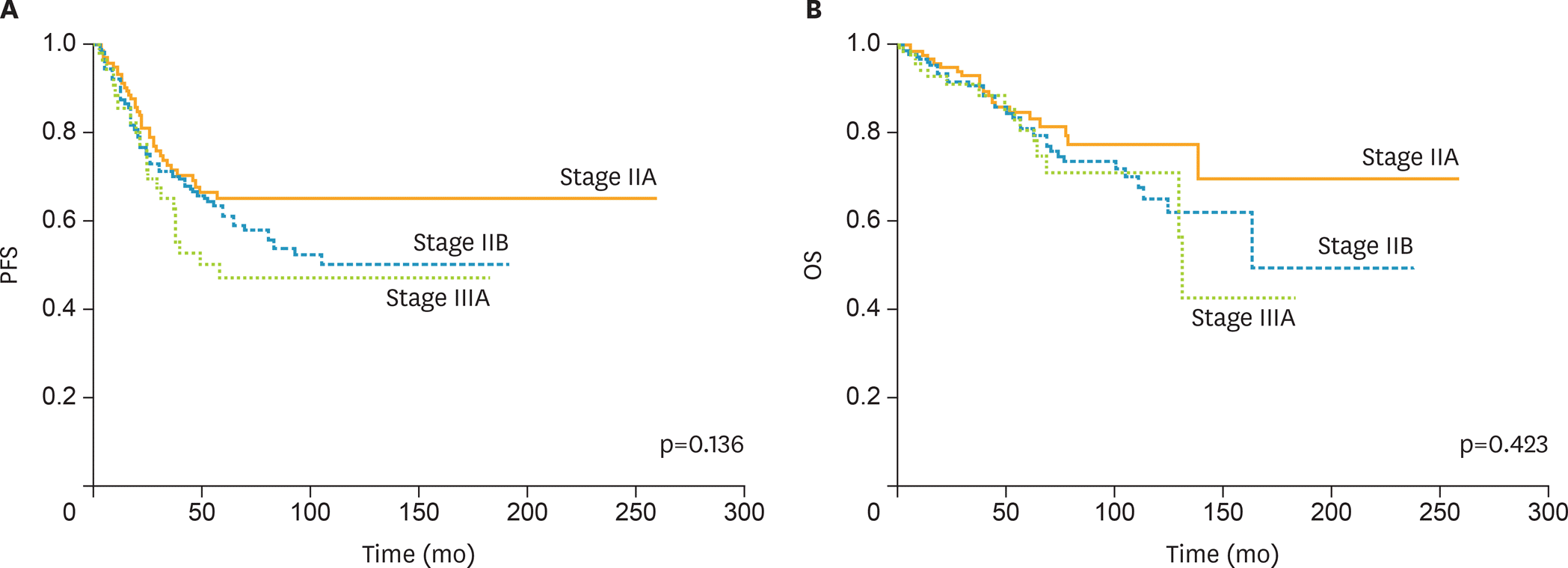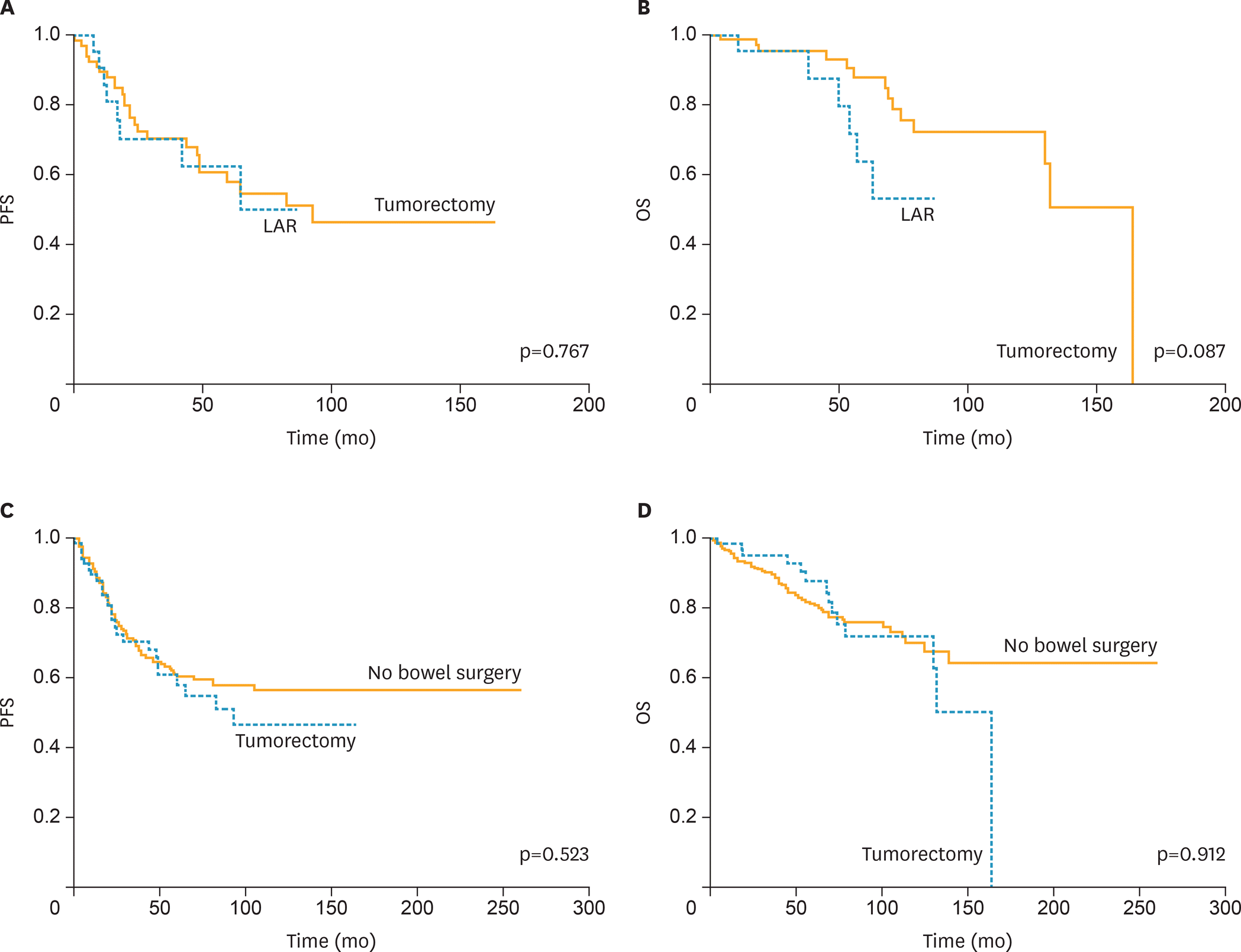Abstract
Objective
To evaluate survival impact of low anterior resection (LAR) in patients with epithelial ovarian cancer (EOC) grossly confined to the pelvis.
Methods
We retrospectively reviewed 397 patients who underwent primary staging surgery for treatment of 2014 International Federation of Gynecology and Obstetrics (FIGO) stage II–IIIA EOC: 116 (29.2%) IIA, 212 (53.4%) IIB, and 69 (17.4%) IIIA. Patients with grossly enlarged retroperitoneal lymph nodes positive for metastatic carcinoma were excluded. Of 92 patients (23.2%) with gross tumors at the rectosigmoid colon, 68 (73.9%) underwent tumorectomy and 24 (26.1%), LAR for rectosigmoid lesions. Survival outcomes between patients who underwent tumorectomy and LAR were compared using Kaplan-Meier curves.
Results
During the median follow-up of 55 months (range, 1–260), 141 (35.5%) recurrences and 81 (20.4%) deaths occurred. Age (52.8 vs. 54.5 years, p=0.552), optimal debulking (98.5% vs. 95.0%, p=0.405), histologic type (serous, 52.9% vs. 50.0%, p=0.804), FIGO stage (p=0.057), and platinum-based adjuvant chemotherapy ≥6 cycles (85.3% vs. 79.2%, p=0.485) were not different between groups. No significant difference in 5-year progression-free survival (PFS; 57.9% vs. 62.5%, p=0.767) and overall survival (OS; 84.7% vs. 63.8%, p=0.087), respectively, was noted between groups. Postoperative ileus was more frequent in patients subjected to LAR than those who were not (4/24 [16.7%] vs. 11/373 [2.9%], p=0.001). The 5-year PFS (60.3% vs. 57.9%, p=0.523) and OS (81.8% vs. 87.7%, p=0.912) between patients who underwent tumorectomy and those who did not were also similar.
Go to : 
References
1. Chang SJ, Hodeib M, Chang J, Bristow RE. Survival impact of complete cytoreduction to no gross residual disease for advanced-stage ovarian cancer: a meta-analysis. Gynecol Oncol. 2013; 130:493–8.

2. Estes JM, Leath CA 3rd, Straughn JM Jr, Rocconi RP, Kirby TO, Huh WK, et al. Bowel resection at the time of primary debulking for epithelial ovarian carcinoma: outcomes in patients treated with platinum and taxane-based chemotherapy. J Am Coll Surg. 2006; 203:527–32.

3. Obermair A, Hagenauer S, Tamandl D, Clayton R, Nicklin J, Perrin L, et al. Safety and efficacy of low anterior en bloc resection as part of cytoreductive surgery for patients with ovarian cancer. Gynecol Oncol. 2001; 83:115–20.

4. Matthiessen P. Risk factors for anastomotic leakage after anterior resection of the rectum. Colorectal Dis. 2006; 8:366.

5. Mäkelä JT, Kiviniemi H, Laitinen S. Risk factors for anastomotic leakage after left-sided colorectal resection with rectal anastomosis. Dis Colon Rectum. 2003; 46:653–60.

6. Richardson DL, Mariani A, Cliby WA. Risk factors for anastomotic leak after rectosigmoid resection for ovarian cancer. Gynecol Oncol. 2006; 103:667–72.

7. Bidzinski M, Derlatka P, Kubik P, Ziolkowska-Seta I, Dańska-Bidzinska A, Gmyrek L, et al. The evaluation of intra- and postoperative complications related to debulking surgery with bowel resection in patients with FIGO stage III-IV ovarian cancer. Int J Gynecol Cancer. 2007; 17:993–7.

8. Aletti GD, Podratz KC, Jones MB, Cliby WA. Role of rectosigmoidectomy and stripping of pelvic peritoneum in outcomes of patients with advanced ovarian cancer. J Am Coll Surg. 2006; 203:521–6.

9. Salani R, Zahurak ML, Santillan A, Giuntoli RL 2nd, Bristow RE. Survival impact of multiple bowel resections in patients undergoing primary cytoreductive surgery for advanced ovarian cancer: a case-control study. Gynecol Oncol. 2007; 107:495–9.

10. Peiretti M, Bristow R, Zapardiel I, Gerardi M, Zanagnolo V, Biffi R, et al. Rectosigmoid resection at the time of primary cytoreduction for advanced ovarian cancer. A multi-center analysis of surgical and oncological outcomes. Gynecol Oncol. 2012; 126:220–3.

11. Derlatka P, Sienko J, Grabowska-Derlatka L, Palczewski P, Danska-Bidzinska A, Bidzinski M, et al. Results of optimal debulking surgery with bowel resection in patients with advanced ovarian cancer. World J Surg Oncol. 2016; 14:58.

12. Park JY, Seo SS, Kang S, Lee KB, Lim SY, Choi HS, et al. The benefits of low anterior en bloc resection as part of cytoreductive surgery for advanced primary and recurrent epithelial ovarian cancer patients outweigh morbidity concerns. Gynecol Oncol. 2006; 103:977–84.

13. Mourton SM, Temple LK, Abu-Rustum NR, Gemignani ML, Sonoda Y, Bochner BH, et al. Morbidity of rectosigmoid resection and primary anastomosis in patients undergoing primary cytoreductive surgery for advanced epithelial ovarian cancer. Gynecol Oncol. 2005; 99:608–14.

14. Jaeger W, Ackermann S, Kessler H, Katalinic A, Lang N. The effect of bowel resection on survival in advanced epithelial ovarian cancer. Gynecol Oncol. 2001; 83:286–91.

15. Eisenkop SM, Spirtos NM. Procedures required to accomplish complete cytoreduction of ovarian cancer: is there a correlation with “biological aggressiveness” and survival? Gynecol Oncol. 2001; 82:435–41.

16. Eisenhauer EL, Abu-Rustum NR, Sonoda Y, Levine DA, Poynor EA, Aghajanian C, et al. The addition of extensive upper abdominal surgery to achieve optimal cytoreduction improves survival in patients with stages IIIC-IV epithelial ovarian cancer. Gynecol Oncol. 2006; 103:1083–90.

17. Kim HS, Kim EN, Jeong SY, Chung HH, Kim YB, Kim JW, et al. Comparison of the efficacy of low anterior resection with primary anastomosis and Hartmann's procedure in advanced primary or recurrent epithelial ovarian cancer. Eur J Obstet Gynecol Reprod Biol. 2011; 156:194–8.

18. Plotti F, Montera R, Aloisi A, Scaletta G, Capriglione S, Luvero D, et al. Total rectosigmoidectomy versus partial rectal resection in primary debulking surgery for advanced ovarian cancer. Eur J Surg Oncol. 2016; 42:383–90.

19. National Comprehensive Cancer Network (US). NCCN Clinical Practice Guidelines in Oncology. Ovarian cancer including fallopian tube cancer and primary peritoneal cancer, version 1. 2016 [Internet]. Fort Washington, PA: National Comprehensive Cancer Network;2016. [cited 2017 Feb 24]. Available from:. http://wwwnccnorg/professionals/physician_gls/pdf/ovarianpdf.
Go to : 
 | Fig. 1.(A) The 5-year PFS (64.9%, 60.8%, and 47.0%; p=0.136) and (B) 5-year OS (84.3%, 80.3%, and 80.6%; p=0.423) in the whole study population (n=397) (solid line: FIGO stage IIA; dotted line: FIGO stage IIB; and dot-and-dash line: FIGO stage IIIA). FIGO, International Federation of Gynecology and Obstetrics; OS, overall survival; PFS, progression-free survival. |
 | Fig. 2.(A) The 5-year PFS (57.9% vs. 62.5%, p=0.767) and (B) 5-year OS (84.7% vs. 63.8%, p=0.087) in patients who had rectosigmoid lesions (solid line: tumorectomy group [n=68]; dotted line: LAR group [n=24]). (C) The 5-year PFS (60.3% vs. 57.9%, p=0.523) and (B) 5-year OS (81.8% vs. 87.7%, p=0.912) in patients who did not receive LAR (solid line: no bowel surgery group [n=305]; dotted line: tumorectomy group [n=68]). LAR, low anterior resection; OS, overall survival; PFS, progression-free survival. |
Table 1.
Patient characteristics (n=397)
| Characteristics | Value |
|---|---|
| Age (yr) | 51 (17–88) |
| Follow-up period (mo) | 55 (1–260) |
| Preoperative CA-125 (U/mL) | 161.0 (3.1–31,600.0) |
| Preoperative colonoscopy | |
| No | 197 (49.6) |
| Yes | 200 (50.4) |
| Rectosigmoid lesions | |
| Absent | 305 (76.8) |
| Present | 92 (23.2) |
| Rectum | 51 |
| Sigmoid colon | 13 |
| Unknown* | 28 |
| Bowel surgery | |
| No | 305 (76.8) |
| Tumorectomy | 68 (17.1) |
| LAR | 24 (6.1) |
| Optimal debulking | |
| No | 10 (2.5) |
| Yes | 335 (84.4) |
| Unknown* | 52 (13.1) |
| Histologic type | |
| Serous | 209 (52.6) |
| Non-serous | 188 (47.4) |
| FIGO stage | |
| IIA | 116 (29.2) |
| IIB | 212 (53.4) |
| IIIA | 69 (17.4) |
| Adjuvant chemotherapy (cycles) | 6 (0–20) |
| Adjuvant chemotherapy ≥6 cycles | |
| No | 62 (15.6) |
| Yes | 335 (84.4) |
| Recurrence | |
| No | 256 (64.5) |
| Yes | 141 (35.5) |
| Death | |
| No | 316 (79.6) |
| Yes | 81 (20.4) |
Table 2.
Univariate and multivariate analysis for independent risk factors of survival outcomes (n=397)
Table 3.
Comparisons of clinicopathologic factors (n=397)
| Characteristics | No bowel surgery (n=305) |
Tumorectomy (n=68) |
LAR (n=24) |
p‡ | ||
|---|---|---|---|---|---|---|
| Value | p* | Value | p† | |||
| Age (yr) | 52.0±11.5 | 52.8±11.4 | 0.618 | 54.5±12.7 | 0.552 | 0.567 |
| Preoperative CA-125 (U/mL) | 671.3±1,607.7 | 702.9±1,042.2 | 0.885 | 2,120.4±6,552.6 | 0.302 | 0.008 |
| Location of rectosigmoid lesions¶ | – | – | 0.759 | – | ||
| Rectum | 33 (78.6) | 18 (81.8) | ||||
| Sigmoid colon | 9 (21.4) | 4 (18.2) | ||||
| Optimal debulking¶ | 0.463 | 0.405 | 0.942 | |||
| No | 8 (3.1) | 1 (1.5) | 1 (5.0) | |||
| Yes | 249 (96.9) | 67 (98.5) | 19 (95.0) | |||
| Histologic type | 0.982 | 0.804 | 0.851 | |||
| Serous | 161 (52.8) | 36 (52.9) | 12 (50.0) | |||
| Non-serous | 144 (47.2) | 32 (47.1) | 12 (50.0) | |||
| FIGO stage | <0.001 | 0.057 | <0.001 | |||
| IIA | 113 (37.0) | 3 (4.4) | 0 | |||
| IIB | 145 (47.5) | 53 (77.9) | 14 (58.3) | |||
| IIIA | 47 (15.4) | 12 (17.7) | 10 (41.7) | |||
| Adjuvant chemotherapy (cycles) | 5.8±1.8 | 5.9±1.6 | 0.760 | 5.5±2.5 | 0.568 | 0.774 |
| Adjuvant chemotherapy ≥6 cycles | 0.884 | 0.485 | 0.650 | |||
| No | 47 (15.4) | 10 (14.7) | 5 (20.8) | |||
| Yes | 258 (84.6) | 58 (85.3) | 19 (79.2) | |||
| Recurrence | 0.623 | 0.669 | 0.883 | |||
| No | 198 (64.9) | 42 (61.8) | 16 (66.7) | |||
| Yes | 107 (35.1) | 26 (38.2) | 8 (33.3) | |||
| Death | 0.913 | 0.652 | 0.612 | |||
| No | 244 (80.0) | 54 (79.4) | 18 (75.0) | |||
| Yes | 61 (20.0) | 14 (20.6) | 6 (25.0) | |||
Table 4.
Operation-related outcomes and morbidity (n=397)




 PDF
PDF ePub
ePub Citation
Citation Print
Print


 XML Download
XML Download